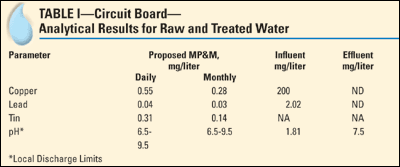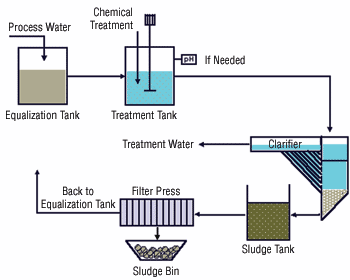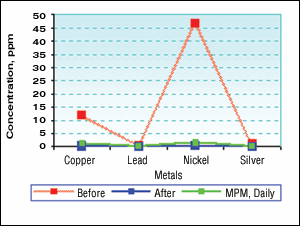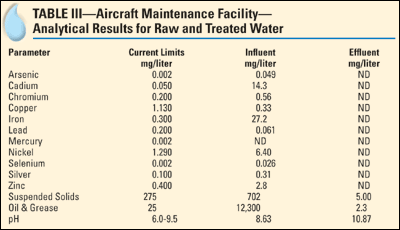Wastewater Treatment Made Simple
A single-step treatment to help finishers meet the MP&M challenge…
The high demands on water resources and landfills resulting from increased industrialization and population growth are problems facing the global community. As industrial discharges continue to grow and the cost of treating such discharges continues to rise, there is a growing need for new technologies and products that are efficient, cost effective and protective of the environment and public health. The EPA’s new proposed Metal Products and Machinery (MP&M) effluent limits, published January 3, 2001 (66 FR 423), have placed an extra burden on industries and presented wastewater treatment professionals with new challenges, namely, to come up with economically feasible and innovative technologies to meet the limits.
The wastewater treatment program established within a facility is influenced by factors such as the nature and volume of the waste streams, discharge limits, available space and the generated waste. The nature and volume of the waste stream and discharge limits will influence the choice of equipment and treatment chemicals. The overall cost of treatment involves operational costs such as energy, labor, treatment chemicals, maintenance and waste disposal. The Resource Conservation and Recovery Act (RCRA) prohibits disposal of sludge/solid waste that does not pass Toxicity Characteristics Leaching Procedure (TCLP). This type of waste is hauled away and treated at waste treatment facilities prior to being landfilled.
Industries that discharge metal-bearing effluent most likely will not be able to meet the proposed limits using conventional hydroxide precipitation alone, which is considered the best available technology (BAT). The industries will have to introduce ion exchange, reverse osmosis or implement a secondary step using a polishing agent such as dithiocarbamate (DTC), in order to achieve the proposed limits. Recently, it has been reported that metal-DTC waste (cadmium, copper, lead and mercury) is unstable, and under the conditions of TCLP testing, the leachate showed levels exceeding RCRA limits. DTC is toxic, and it has deleterious effects on the environment, e.g., the case of the dithiocarbamates spills into the White River in Anderson, Indiana in 1999 that killed more than 80,000 fish along a 50 mile stretch.
Aquasil® is a single-step treatment with enhanced efficiency in removing contaminants such as heavy metals, oil and grease, organic matters and suspended solids simultaneously. It employs proprietary advanced materials that are made to fit the chemistry of the particular waste stream. The products are used in both batch and continuous processes, and effluent can be treated at low, neutral or moderately high pH. It overcomes problems associated with hardness and, in most cases, the presence of complexing or chelating agents, surfactants and detergents. Figure 1 illustrates a continuous setup of the treatment.
Case Studies
Case 1: Circuit Board
A circuit board manufacturer in the Midwest generates about 28,400 liters (7,500 gal) of wastewater daily. The waste stream is acidic (pH = 1.8) and contains mainly copper and lead, with tin and nickel as minor metallic components. Additionally, the waste stream also contains several cleaners that have various chelating agents. The treatment employs hydroxide precipitation along with dithiocarbamate (DTC), due to the presence of chelates. The facility is looking for an alternative technology that can eliminate the use of DTC and bring about compliance with the EPA’ s proposed MP&M effluent limits.
The acidic waste stream was treated with the new treatment without any pH adjustment. Analytical data shown in Table 1 indicate that the treatment brought the levels of copper and lead below the new MP&M limits. The treatment produced large, dense floc that settled efficiently. Moreover, the treatment eliminated DTC, caustic and polymer. The treated water can be reused. The treatment also generates less waste, which passes the TCLP test.
Case 2: Metal Finishing
A plating facility on the East Coast has an acidic waste stream (pH about 2), that comes from two sources, cyanide and non-cyanide rinses. The waste contains mainly nickel and copper along with some lead and silver. Cyanide is destroyed with calcium hypochlorite at a pH between 9-11. The non-cyanide rinses are neutralized with Mg(OH)2 (magnesium hydroxide) to maintain a pH of about 5.25-8. Both cyanide and non-cyanide rinses are collected in two 2,500-gal equalization tanks. The wastewater is pumped from equalization tanks to a reaction tank such that a ratio of cyanide to non-cyanide of 1:3 is maintained.
The pH is adjusted to 9.9-10.4, and a coagulant is added. The wastewater then flows to a flash-mixing tank where a flocculent is added and then to a clarifier. Sludge from the clarifier is pumped to a sludge holding tank and dewatered in a filter press. Treated water flows to the final tank where pH is adjusted to between 6.5-9.5 prior to discharge.
The treatability study was done on the wastewater composite (pH = 2-3) without Mg(OH)2 neutralization. The wastewater was treated directly. Large, dense floc formed within a few minutes and settled quite efficiently. The treated effluent was clear and free of pin floc. Filtration was easy and filter cake dried well. Final pH was about 9.5-10. Treatment eliminated the use of magnesium hydroxide, caustic, coagulant and flocculent.
Metal concentrations in the effluent are far below the proposed MP&M limits. Table 2 shows analytical results of raw and treated effluent. Moreover, the treatment generated a much drier cake.
Case 3: Aircraft Maintenance Facility
An aircraft maintenance and service facility in the Southeast generates an oily waste that contains high levels of heavy metals, emulsified oil and heavy petroleum oil. Through an environmental initiative, the facility was required to implement an innovative technology into its operation. The proposed technology was evaluated for environmental benefits, labor and cost savings, and the ability to interface with the various routine operations.
A treatability study was conducted on a sample of the oily waste. As a result, one treatment was chosen as the most cost effective technology, and a fully automated batch system was installed to treat the oily waste.
Table 3 shows that the system delivered results far below discharge requirements for all parameters. The system achieved almost 100% percent removal of heavy metals and oil and grease and more than 99% of suspended solids. The system requires very little maintenance and only minimal operator attention.
Before and after treatment analytical data for the above cases were provided by the respective facilities.
All conventional techniques used in the treatment of waste streams produce sludge/waste that can be hazardous due high concentrations of contaminants. Safe disposal of such waste is troublesome and the problem is aggravated by the continued increase in the number of wastewater treatment plants. Currently, waste is transported to treatment plants where it undergoes further treatment to render it suitable for disposal. This adds to the overall cost of treatment.
Waste generated by this particular treatment is already stabilized and does not require any further treatment to render it suitable for disposal in a landfill. Characteristic waste passes the TCLP test and meets regulatory requirements for disposal as nonhazardous material. Listed waste also passes the TCLP test and can be disposed of likewise once exclusion has been granted. Table 4 shows TCLP test results for the aircraft maintenance waste (see case 3).
This technology is a fast process with enhanced efficiency in removing contaminants such as heavy metals, oil and grease, organic matters and TSS, simultaneously. The treatment lowers the levels of chromium (VI), arsenic, selenium, phosphate, fluoride, TDS, COD and phenol. The treatment is easy to implement and operate, effective, requires less energy and maintenance, delivers high-quality effluent, achieves zero-discharge through the recycle/reuse, and generates nonhazardous waste that does not need further treatment prior to disposal. Moreover, it brings about compliance.
Read Next
Episode 45: An Interview with Chandler Mancuso, MacDermid Envio Solutions
Chandler Mancuso, technical director with MacDermid Envio discusses updating your wastewater treatment system and implementing materials recycling solutions to increase efficiencies, control costs and reduce environmental impact.
Read MoreDelivering Increased Benefits to Greenhouse Films
Baystar's Borstar technology is helping customers deliver better, more reliable production methods to greenhouse agriculture.
Read MoreA ‘Clean’ Agenda Offers Unique Presentations in Chicago
The 2024 Parts Cleaning Conference, co-located with the International Manufacturing Technology Show, includes presentations by several speakers who are new to the conference and topics that have not been covered in past editions of this event.
Read More
















.jpg;maxWidth=300;quality=90)










